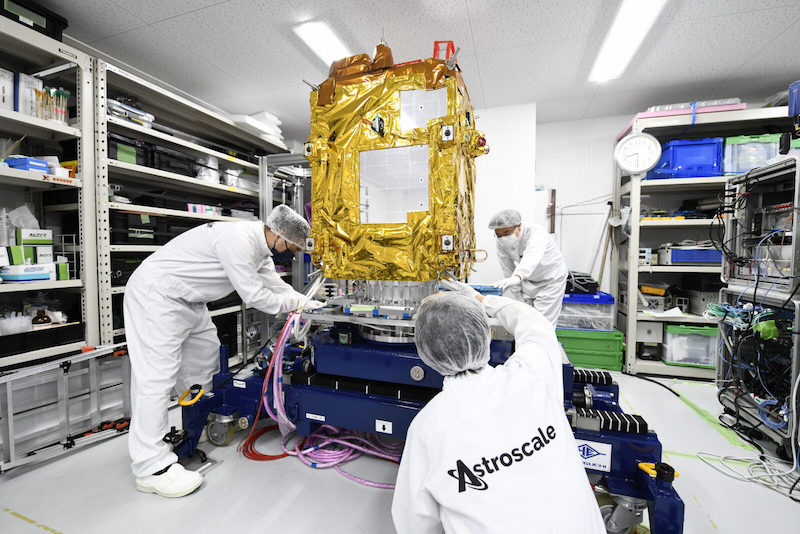Latest News
Astroscale Hopes ADRAS-J Mission Will Lay the Groundwork for Commercial Debris Removal

Astroscale’s ADRAS-J spacecraft. Photo: Astroscale
Astroscale is ready to launch its ADRAS-J mission, which will conduct a close approach and orbit around a piece of space debris. The spacecraft is ready, but a launch window is on hold after Rocket Lab’s recent mission failure. Astroscale leadership said ADRAS-J was set to launch in early November, but Rocket Lab has paused missions while it investigates the failure earlier this month.
ADRAS-J, which stands for Active Debris Removal by Astroscale-Japan, will be the world’s first attempt to safely approach and characterize an existing piece of large debris through rendezvous and proximity operations (RPO). Astroscale previewed the mission in a press conference on Sept. 28, saying it will lay the groundwork for future commercial service.
“ADRAS-J is our next step in building groundbreaking technologies that will lead to safe, affordable, and reliable satellite servicing that’s going to expand the ecosystem and maintain a safe and sustainable orbit,” Astroscale COO Chris Blackerby said.
The mission is the first phase of a larger program at JAXA, the Commercial Removal of Debris Demonstration project (CRD2). Astroscale was awarded the contract for the mission in 2020. ADRAS-J is the first of two missions for the program. Astroscale is not disclosing the price of the contract.
The first phase will demonstrate that Astroscale can approach a non-cooperative object — an H-IIA rocket upper stage launched in 2009 — without docking to it, and inspect it. The second phase in a later mission will demonstrate docking to the client and demonstrating removal.
Astroscale Chief Engineer Gene Fujii outlined some of the technologies involved with this first demonstration, saying they are the “most difficult aspects of RPO.” This involves launching in order to rendezvous with an object, including knowing where the object is. It also includes absolute navigation, approaching the object once separated from the launch vehicle. Then it requires relative navigation, using onboard instruments to detect the client, and safely approach. And finally, diagnostics and fly-around, to observe the client.
While the ELSA-d mission demonstrated rendezvous with an active client, this mission is a derelict object, with no GPS receiver.
To manage this complex mission, Astroscale is using a mix of onboard autonomous capability along with ground operations that it says will make sure the approach is safe and minimize the chance of creating additional debris.
The ADRAS-J spacecraft is about 150 kg in mass, including fuel. It has two articulating, two-panel solar arrays, and uses green monopropellant fuel used by 12 thrusters. The spacecraft has a custom rendezvous payload sensor suite that includes visible cameras, infrared cameras, LiDAR, cameras, laser rangefinders, LED lighting, and a custom processing unit.
Fujii commented on the complexity of the mission, that it’s not about the specific hardware, but in how Astroscale brought it together.
“There isn’t any spectacular new hardware or technology. What’s unique is the way we assembled everything as a system and got it to work to do this mission, because this mission has never been done before,” he said. “We had to figure out what hardware, software, and integration [was] needed. That was one of the biggest challenges — doing something that’s never been done before.”
Astroscale expects to achieve the major portions of the mission within three to six months after launch.
This mission is key to demonstrate technologies on Astroscale’s roadmap to making on-orbit servicing routine by 2030, CTO Mike Lindsay said.
“ADRAS-J is a stepping stone that’s taken us from this phase where we’re doing demonstrations, proving to ourselves that we are capable of this, [to] delivering a service with a national client,” Lindsay said. “This is this proving ground that will then unlock a diverse set of clients in the future and new services.
As Astroscale works toward commercial service, Blackerby was honest that this is a “nascent” market. While Astroscale is seeing a “significant” amount of government interest, there are signs of commercial interest as well.
Lindsay commented on the commercial use cases: “Several commercial customers or institutional customers may be interested in understanding what their satellites look like after spending years in orbit. If there are anomalies or failures, impacts or anomalies to study in space inspection is a great way to better understand that,” Lindsay said.
Stay connected and get ahead with the leading source of industry intel!
Subscribe Now